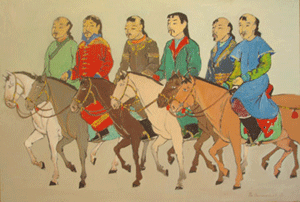The “Eternal Sky” is a profoundly meaningful concept in Mongolian tradition. For a people ever on the move, criss-crossing the vast sweep of the Eurasian steppes, the ever-present sky was invested with spiritual significance. In the time of Chinggis Khan, it is believed, the eternal sky blessed the Mongol leader in his imperial ambitions. In our own time, as Mongolia seeks to re-establish its identity in Asia, the Mongol Zurag (literally: Mongol picture) is being reinvented. The traditions of the past are being revisited in art: the legendary power of Chinggis Khan, the brilliant flat colors of traditional arts, the crafts and activities of nomadic culture, and the celebration of life under the endless canopy of the Mongolian sky.
"Eternal Sky: Reviving the Art of Mongol Zurag," on view at the IEAS Gallery April 22 through July 15, features the work of artist and calligrapher Narmandakh Tsultem. Since 1988, when the decades-long repression under Mongolia’s Soviet-style regime eased, Tsultem has taught Mongol Zurag style painting at Mongolian University of Arts and Culture. Her work encourages emerging young artists to look for their inspiration to the traditional culture of Mongolia.
Two events will be held in conjunction with this exhibition. On April 29, a panel entitled "Mongolia: On the Eve of Modernity" will examine Mongolia during the Qing dynasty (URL: http://ieas.berkeley.edu/events/2009.04.29a.html). On May 7, artist Narmandakh Tsultem, Institute of Fine Art at the Mongolian University of Arts and Culture, Ulaanbatatar, Mongolia, will speak about her work in this exhibition. Mongolian throat singing and musical performances will be featured at this event (URL: http://ieas.berkeley.edu/events/2009.05.07.html).
Image

